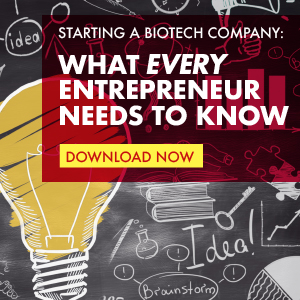Biotech Startups: How to meet investors and lead a successful meeting

Biotech startup companies face many challenges, but one of the most common is how to meet investors and how to lead a fruitful investor meeting.
The following are pieces of advice from investors on what they want and how they want you to approach them. The advice comes from Sinclair Dunlop of Epidarex Capital; Sam Hall of Appletree Partners; Rick Jones of BioAdvance; Dennis J. Purcell of Aisling Capital; Jeremy Springhorn of Syros Pharmaceuticals; and David Steinberg of PureTech from a previous edition of BioPharm America™, which will be taking place again this year in Boston, September 5–6.
Where to focus in your investor pitch
Think of your pitch as the introductory paragraph in an email that you want someone to open. You may never get past that first meeting if the pitch is no good. Purcell advises that you figure out your hook, and focus on that. With 600 to 700 pitches a year on their books, having a sleek presentation is more memorable than cramming everything into 30 minutes, anyway. Keep in mind that the whole point of the first meeting is to get a second meeting.
 That said, be focused but make sure you come prepared with a high-level overview covering all the significant bases, says Jones. Be prepared for a conversation that could go any number of different directions. And be realistic. The two biggest turnoffs in presentations according to Jones are too much detail on a single point and over-promising or exaggerating the importance of your asset, company or research.
That said, be focused but make sure you come prepared with a high-level overview covering all the significant bases, says Jones. Be prepared for a conversation that could go any number of different directions. And be realistic. The two biggest turnoffs in presentations according to Jones are too much detail on a single point and over-promising or exaggerating the importance of your asset, company or research.
In other words, don’t waste 25 minutes going into extreme detail about an area of science that may not be of interest to the investor. Pay attention to visual cues. And leave time for discussion about other issues in the company. And don’t over-promise; just come prepared with a reasonably comprehensive but brief overview. The best slideshows are five slides, because the deal happens in the Q&A.
Find your uniqueness for the investor pitch
According to Dunlop, being clear about what you’re doing that’s unique can separate you from the pack early on. Provide information not just on your therapeutic approach but on what differentiates you in the field that you are pursuing. You don’t need to cover every disease in the human body, but provide specific applications for your technology, and explain your approach.
A major factor in what makes you unique is your team. Dunlop recommends adding information about yourself and your team. Hall agrees to this approach, recommending that you tie your pitch to the problem you are solving, how you are solving it, and why that solution is unique.
A good way to prepare is to create a SWOT analysis of your company on strengths and opportunities, and then pick one or two to focus on in your meeting, rather than bringing an exhaustive laundry list that may result in diverting you from your main point.
Keep asking yourself why you are asking for partners or investors. The answer should be practical and achievable. If you claim your target hits every application, the VC will probably react negatively, envisioning a prolonged and expensive relationship.
Read about 12 VCs who matter in biotech, but you never read about.
Value and efficacy
It may seem obvious, but be sure to include the value inflection point for the funding you seek, i.e., where this round of funding will get you. You have to convince your audience that value is going to be created by the amount of funding you are going to get in this round, said Dunlop. Part of that discussion must cover efficacy or even early hints of how well your drug is actually working, said Springhorn.
Stage of development should also be part of your pitch. This goes back to focusing on the most important hook that the investor wants to hear. Every investor is different, but they all want you to get to the point and stay away from the hyperbole as much as possible. Always go with a direct approach and show that you really understand what you are doing and you’ve got a plan to get from point A to point B with their money.
Reveal challenges in the investor pitch
Don’t assume that if you don’t mention problems, they won’t come up. It’s important to provide a high-level summary of potential challenges and how you plan to mitigate those challenges. Bring any problems you foresee to light, because it directly feeds into how you will use the money, said Hall. This can turn negative things about your company around to positive. And anyway, your challenges may the first questions that investors are going to ask you, so be prepared.
Be balanced. In the due diligence process, the problems will come to light, anyway, so by addressing them up front, you reduce unwelcome surprises later on and imply to investors that you have a sophisticated level of decision making. All VCs have had their share of failures, but it is truly difficult to find out about a deal killer late in the process. Purcell advised, ask yourself, what keeps you up at night, what should we be worried about? Show some balance.
And don’t forget to explain how you’re protecting your IP, and how you’re protecting your product and your ideas, said Steinberg.
Confidence and rapport
Confidence does not mean that you know everything or have all the answers. Confidence means that you understand the real benefits you bring to the table, and can convey your ideas with passion and good data. Hall said it’s ideal to have a discussion where investors know they are entering a partnership with people with whom they can discuss any problems and any solutions.
In the end, it won’t be your slides or your presentation that gets you the next meeting. There has to be interaction. In preparing for those interactions, practice verbally explaining your ideas without slides so you can insert the passion behind it.
And be real. If you’re nervous, you can still project confidence by being conversational. Try not to be too casual with your hands in your pockets and your posture, said Steinberg. Confidence comes across, even in just 30 seconds. It has been overheard from investors that ‘If I don’t want to go and have a beer with this person, I’m not going to want to put money in them.’
How to meet investors
If you want to get a meeting, ask.
Having prior interaction can really help to get a one-to-one meeting. Do a little bit of homework, look at online bios or partnering reports, or reach out to the scientist who evaluates opportunities for advice.
Finding ways on how to meet investors can be a challenge, but doing a little bit of researching your audience to know which partners or which associates in the team you’ll need to present to can provide a lot of guidance as to the way the conversation is going to go. Unless it feels like a conversation, it’s not going well, said Dunlop. Then again, if you’re talking about the weather, it’s not really a good conversation. You need to quickly establish a point of common ground to build a connection.
But how and where can you meet with investors if you are an early stage biotech startup? BioPharm America™ has joined with Biotech Week Boston to help you get your company in front of more potential partners. Not only will you be able to directly access 800+ life science attendees during two impactful days, but you can partake in some of the 2,300+ one-to-one meetings or learn from the 100+ company presentations.
Mark your calendar for BioPharm America, September 5–6, 2018, in Boston, MA. 
Content published on September 14, 2016, revised and updated April 27, 2018